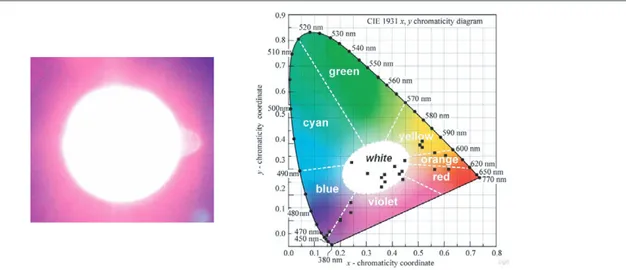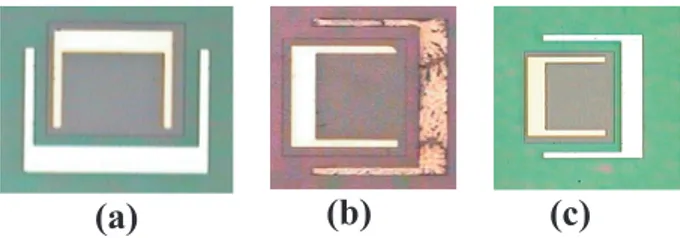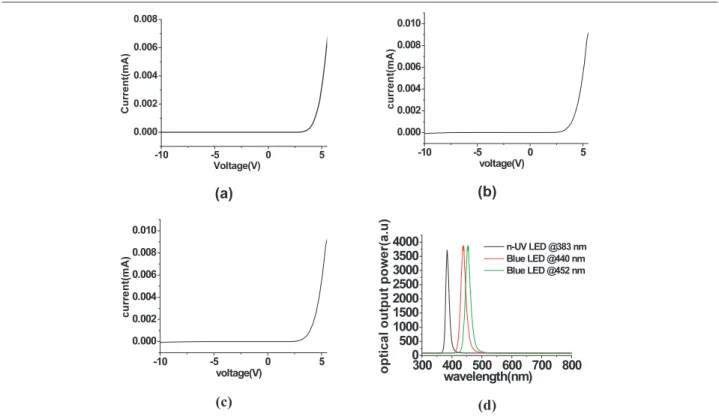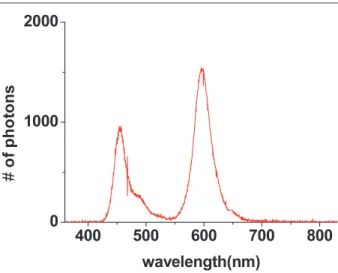Journal of Optics A: Pure and Applied Optics
Nanocrystal-based hybrid white light generation
with tunable colour parameters
To cite this article: S Nizamoglu and H V Demir 2007 J. Opt. A: Pure Appl. Opt. 9 S419
View the article online for updates and enhancements.
Related content
White light generation using CdSe/ZnS core–shell nanocrystals hybridized withInGaN/GaN light emitting diodes S Nizamoglu, T Ozel, E Sari et al.
-White light generation tuned by dual hybridization of nanocrystals and conjugated polymers
Hilmi Volkan Demir, Sedat Nizamoglu, Tuncay Ozel et al.
-Hybrid white light sources based on layer-by-layer assembly of nanocrystals on near-UVemitting diodes
Sedat Nizamoglu and Hilmi Volkan Demir
-Recent citations
White emitting CdS quantum dot nanoluminophores hybridized on near-ultraviolet LEDs for high-quality white light generation and tuning
Sedat Nizamoglu et al
-White light generation by resonant nonradiative energy transfer from epitaxial InGaN/GaN quantum wells to colloidal CdSe/ZnS core/shell quantum dots Sedat Nizamoglu et al
-Tuning shades of white light with multi-color quantum-dot–quantum-well emitters based on onion-like CdSe–ZnS heteronanocrystals
Hilmi Volkan Demir et al
E-mail:volkan@bilkent.edu.tr(H V Demir)
Received 31 January 2007, accepted for publication 28 March 2007
Published 24 August 2007
Online at
stacks.iop.org/JOptA/9/S419
Abstract
We present the hybridization of CdSe/ZnS core–shell nanocrystals (NCs) on
InGaN/GaN based blue/near-UV LEDs to generate light widely tunable
across the visible spectral range and especially within the white region of the
CIE (1931) chromaticity diagram. We report on the design, growth,
fabrication and characterization of these hybrid NC-LEDs. In 26 NC-LED
samples, we experimentally show the effect of the NC concentration and NC
film thickness on tuning the colour properties of the generated light
(tristimulus coordinates, colour rendering index and correlated temperature)
and further compare layer by layer assembly and blending of NCs for
integration in LEDs. With greatly tunable colour properties, these hybrid
white light sources hold promise for future lighting and display applications.
Keywords:nanocrystals, white light generation, LEDs
(Some figures in this article are in colour only in the electronic version)
Within the next five years, it is likely that white light emitting diodes (WLEDs) will be used for all external lighting functions on vehicles [1]. Because of such wide-scale potential use, WLEDs have attracted both scientific attention and commercial interest [2]. Different approaches for white light generation such as multi-chip WLEDs, monolithic WLEDs and colour-conversion WLEDs have been extensively investigated [3–5]. Among these, multi-chip white LEDs (and monolithic WLEDs, in principle, for the same matter) tend to exhibit higher electrical-to-light conversion efficiencies when compared with colour-conversion WLEDs, for the multi-chip WLEDs do not have additional energy losses caused by the Stokes shift and nonradiative recombination, unlike in the phosphor coating of colour-conversion WLEDs. Additionally, multi-chip WLEDs do not suffer ageing problems related to the phosphor, which affects the lifetime of colour-conversion WLEDs [6]. However, for multi-chip WLEDs, the driving electric circuit is typically comparatively complex for general illumination purposes, leading to increased costs [5]. As a result, the colour-conversion approach provides an advantage specifically in having simple circuits (and thus reduced
cost) when compared to the multi-chip WLED approach. Today, using the colour-conversion technique, phosphor-based WLEDs have been widely commercialized and are currently in use. In phosphor-based colour conversion, however, difficulties in controlling granule size systematically, and mixing and depositing films uniformly pose the most fundamental disadvantages, which result in undesired visible colour variations [7].
As an alternative approach, nanocrystals (NCs) have recently been used for colour conversion in white light generation. To date we have introduced white light generation using CdSe/ZnS core–shell nanocrystals of single, dual, trio and quadruple combinations hybridized with blue InGaN/GaN LEDs [8,9]. Also, a blue/green two-wavelength InGaN/GaN LED coated with a single type of red NC and a blue InGaN/GaN LED with a single type of yellow NC and a dual type of red and green NCs have been reported [10–12]. In this paper, we present the hybridization of CdSe/ZnS core– shell nanocrystals (NCs) on InGaN/GaN-based blue/near-UV LEDs to generate light widely tunable across the visible spectral range and especially within the white region of the
S Nizamoglu and H V Demir
Figure 1. A photograph of white light generation from one of our hybrid white NC-WLEDs (left) and tristimulus coordinates of our hybrid NC-WLEDs on the CIE (1931) chromaticity diagram.
CIE (1931) chromaticity diagram, as shown as an exemplary implementation in figure 1 (left). Here we report on the design, growth, fabrication and characterization of these hybrid NC-LEDs. In 26 of our NC-LED samples, we experimentally show the effect of the NC concentration and NC film thickness on tuning the colour properties of the generated light (tristimulus coordinates, colour rendering index and correlated temperature), as shown on the CIE chromacity diagram in figure1(right). We further compare layer by layer assembly and blending of NCs for integration on LEDs. Using combinations of nanocrystals and organizing them mixed and/or unmixed in layers, we tune the colour parameters of the generated light.
We adjust the colour properties (tristimulus coordinates, correlated colour temperature and colour rendering index) of the generated white light by setting the device parameters including the thickness and order of the NC films and the type and concentration of NCs. The order of NC films, with a different NC type in each film, determines the level of reabsorption of the photons emitted by the preceding NC layers. The film thickness and NC density affect the level of conversion from incident photons to emitted/transmitted photons for each NC layer. The type of NCs determines the intervals of the visible spectrum designed to contribute to white light. Therefore, the ability to control such hybrid device parameters makes it possible to generate the intended white light spectrum in the visible.
We use four types of CdSe/ZnS core–shell NCs from Evident Technologies. Their photoluminescence in the visible spectral range corresponds to cyan, green, yellow and red. The NC diameters range from 1.9 to 5.2 nm. We use these NCs blended in host resin with a size distribution of ±5%. We use both PMMA and UV-curable resin to make NC films that enable us to adjust the concentration. When we hybridize the NCs in toluene and host polymer on LEDs, since the toluene solvent evaporates, given the total number of NCs in the solution, the amount of polymer controllably determines the NC concentration. Usually the NC concentration we use for hybridization ranges from 3.04 to 140 nmol/1 ml of resin. We can use NC film thickness ranging from a few micrometre
Figure 2. Photoluminescence spectra of our CdSe–ZnS core–shell nanocrystals in host polymer.
to 1700μm, depending on the concentration of NC film. Our cyan, green, yellow and red NCs exhibit photoluminescence (PL) peaks at 500, 540, 580 and 620 nm, respectively, as characterized at our labs [8] and shown here in figure2.
We use an n-UV LED and two types of blue InGaN/GaN LEDs for integration. The n-UV LED has a peak electroluminescence at 383 nm, one of the blue LEDs at 440 nm and the other at 452 nm. We use an epitaxial layer design similar for the n-UV LED and the two blue LEDs. The difference between the n-UV and blue LEDs is the epitaxial growth temperatures and the thickness of the active layers (2– 3 nm for the n-UV LED and 4–5 nm for the blue LEDs). The difference between the two blue LEDs is only the change of the epitaxial growth temperatures of their respective active layers. The design of these InGaN/GaN LEDs is presented along with the thickness of each epitaxial layer in figure3.
We use a GaN dedicated metal–organic chemical vapour deposition (MOCVD) system (Aixtron RF200/4 RF-S) for the growth of our epitaxial layers at Bilkent University Nanotechnology Research Center. We start with a 14 nm thick GaN nucleation layer and a 200 nm thick GaN buffer layer to increase the crystal quality of the device epitaxial layers. S420
Figure 4. Micrographs of our fabricated n-UV and blue LEDs: (a) withλEL= 383 nm, (b) with λEL= 440 nm and (c) with λEL= 452 nm.
Subsequently, we grow a 690 nm thick, Si doped n-type contact layer. We then continue with the epi-growth of five InGaN wells and GaN barriers as the active layers of our LEDs. The growth temperature of this active region determines the amount of In incorporation into the wells, which in turn adjusts the emission peak wavelength. Therefore, we use distinct active region growth temperatures for our LEDs. The n-UV LED active layer is grown at 720◦C for 383 nm EL peak, while one of the blue LEDs is grown at 682◦C for 440 nm EL peak and the other blue LED at 661◦C for 452 nm EL peak. Finally, we finish our growth with p-type layers that consist of Mg-doped, 50 nm thick Al0.1Ga0.9N and 120 nm thick GaN layers as the contact cap. Following the growth, we activate Mg dopants at 750◦C for 15 min.
In the device fabrication, we use standard semiconductor processing including photolithography, thermal evaporator (metallization), reactive ion etch (RIE) and rapid thermal annealing. Our p-contacts consist of Ni/Au (15 nm/100 nm) and are annealed at 700◦C for 30 s under N2 purge. On the other hand, our n-contacts consist of Ti/Al (100 nm/2500 nm) and are annealed at 600◦C for 1 min under N2purge. The top-view micrographs of our fabricated n-UV and blue LEDs (with λEL=383 nm in (a),λEL=440 nm in (b) andλEL=452 nm in (c)) are shown in figure4. For on-chip integration, following the surface treatment, we hybridize the LED top surface with various types of NCs in host polymer. Our n-UV LED and blue LEDs have turn-on voltages approximately at 6 and 4 V, and electroluminescence (EL) peak wavelengths at 383, 440 and 452 nm, respectively, as shown in figure5.
The operating principle of these hybrid NC-WLEDs relies on the hybrid use of the LED as the pump light source and the integrated NC film as the photoluminescent layer. When electrically driven, the LED optically pumps the NCs. The photoluminescence of these NCs and the electroluminescence
2, we integrate 25 μl NCs in toluene with 3.1 μl PMMA solution corresponding to a concentration of 2.36μmol ml−1. For each subsequent sample (from sample 2 to sample 6), we increase the NC solution by multiples of 25μl and PMMA by 3.1μl. For sample 6, we end up with 150μl NC solution and 18.75μl PMMA, corresponding to a final concentration of 2.36μmol ml−1. Consequently, on the CIE chromaticity diagram, the(x, y)tristimulus coordinates of these samples begin with (0.14, 0.03) on the blue edge for 452 nm and reach (0.43, 0.28) in the white region. The correlated colour temperature ranges from cool white colours to warm white colours as we increase the hybridized NCs solution. Furthermore, the colour rendering index starts with −51.5, increases in each step and reaches 15.8 as a dichromatic source. Therefore, we observe experimentally that the thickness of the hybridized NC thin films significantly shifts the colour parameters of the resulting hybrid LEDs. Figure6shows the optical spectrum of sample 6 to observe the increase in the yellow peak with respect to electroluminescence of blue LED. For samples 7–9, we increase green NC volume in toluene by 25μl and PMMA by 3.1μl, corresponding to a concentration of 5.59μmol ml−1, and on top of the green NC film we place 150μl yellow NCs and 18.75μl PMMA having a concentration of 2.36μmol ml−1. As a result, the tristimulus coordinates of these samples move from (0.44, 0.29) to (0.52, 0.37). The corresponding correlated colour temperatures move towards warm white to 1754 K.
When 150μl yellow NCs and 18.75μl PMMA with a concentration of 2.36μmol ml−1 are hybridized on the blue LED at 452 nm, the colour rendering index is only 15.8 (due to the dichromacity of the source). However, when 75μl green NC and 9.3μl PMMA with a concentration of 5.59μmol ml−1and 150μl yellow NC and 18.75μl PMMA with a concentration of 2.36μmol ml−1are hybridized layer by layer in the respective order, the colour rendering index becomes 50.7 (because of the trichromaticity of the source). Figure 7 shows the optical spectrum of this hybrid LED (sample 9). For samples 10 and 11, we similarly observe an increase in correlated colour temperature and colour rendering index by adding red NCs instead of green NCs.
For samples 12–15, we hybridize the cyan NC film first and then add 150 μl yellow NCs and 18.75 μl PMMA having a concentration of 2.36 μmol ml−1 on top of it. In each sample, we add 25 μl cyan NCs in toluene and 3.1μl PMMA, corresponding to an additional concentration
S Nizamoglu and H V Demir
Figure 5. (a) I V of n-UV LED (λEL= 383 nm), (b) I V of blue LED (λEL= 440 nm), (c) I V of blue LED (λEL= 452 nm) and (d) electroluminescence of n-UV LED and two blue LEDs.
Table 1. Our hybrid NC-WLED sample characteristics. (C: cyan NC; G: green NC; Y: yellow NC; R: red NC; * denotes blended NC hybridization.) Sample # Hybridized nanocrystals LED λEL(nm) Concentration (μmol ml−1) x y Tc (K) Ra 1 — 452 — 0.14 0.03 34 367 −51.5 2 Y 452 2.36 0.15 0.04 34 367 −40.2 3 Y 452 2.36 0.16 0.06 34 367 −28.6 4 Y 452 2.36 0.20 0.10 34 366 −10.1 5 Y 452 2.36 0.24 0.13 34 366 −3.8 6 Y 452 2.36 0.43 0.28 1 882 15.8 7 G, Y 452 5.59, 2.36 0.44 0.29 1 989 37.5 8 G, Y 452 5.59, 2.36 0.45 0.33 2 165 54.5 9 G, Y 452 5.59, 2.36 0.52 0.37 1 754 50.2 10 R, Y 452 0.88, 2.36 0.57 0.30 1 121 42.2 11 R, Y 452 0.88, 2.36 0.62 0.30 1 000 50.7 12 C, Y 452 12.05, 2.36 0.24 0.13 34 366 −3.4 13 C, Y 452 12.05, 2.36 0.36 0.23 2 651 32.4 14 C, Y 452 12.05, 2.36 0.36 0.27 3 228 48.3 15 C, Y 452 12.05, 2.36 0.42 0.31 2 311 50.2 16 Y 440 0.11 0.37 0.25 2 692 14.6 17 C, Y 440 0.37, 0.11 0.37 0.28 3 246 19.6 18 G, Y, R 452 0.27, 0.11, 0.025 0.30 0.28 7 521 40.9 19 C, G, Y, R 452 0.37, 0.27, 0.1, 0.025 0.24 0.33 11 171 71.0 20∗ C, Y, R 452 2.54, 0.19, 0.06 0.44 0.26 1 625 38.8 21 C, Y, R 452 2.8, 2.8, 2.8 0.20 0.10 34 366 1.9 22 C, Y, R 383 2.8, 2.8, 2.8 0.51 0.39 1 979 71.9 23∗ C, Y, R 383 2.54, 0.19, 0.06 0.61 0.36 1 238 74.3 24 C, R 452 2.8, 2.8 0.20 0.11 34 367 4.0 25∗ C, R 452 2.73, 0.06 0.24 0.13 34 366 −13.8 26∗ C, R 383 2.73, 0.06 0.57 0.37 1 477 47.6 27 C, R 383 2.8, 2.8 0.52 0.41 1 977 42.1
of 12.05 μmol ml−1. By increasing the incorporation of cyan NCs, the tristimulus coordinates move closer to the cyan part of the CIE chromaticity diagram, which would imply
the correlated colour temperature to increase. However, on the contrary, in our samples we observe that the correlated colour temperature of our hybrid NC-LEDs decreases and S422
Figure 6. Electroluminescence spectrum of 150μl yellow NCs (λPL= 580 nm) and 18.75 μl PMMA corresponding to a film concentration of 12.05 μmol ml−1hybridized on blue LED (λEL= 452 nm) measured at an injection current level of 5 mA at room temperature.
Figure 7. Electroluminescence spectrum of 75μl green NC and 9.3 μl PMMA corresponding to a film concentration of
5.59 μmol ml−1and 150μl yellow NCs (λPL= 540 and 580 nm) and 18.75 μl PMMA corresponding to a film concentration of 12.05 μmol ml−1hybridized with blue LED (λEL= 452 nm) at an injection current level of 5 mA and the electroluminescence spectrum of 50μl red NC and 6.2 μl PMMA corresponding to a film concentration of 0.88 μmol ml−1and 150μl yellow NCs (λPL= 620 and 580 nm) and 18.75 μl PMMA corresponding to a film
concentration of 12.05 μmol ml−1hybridized on blue LED (λEL= 452 nm) measured at an injection current level of 5 mA at room temperature.
becomes a warmer light source. According to our observations, this behaviour stems from the reabsorption of the photons generated by the cyan NCs in the top yellow NC film. Figure8shows the optical spectrum of 75μl cyan and 9.3μl PMMA corresponding to a concentration of 12.05μmol ml−1 and 150 μl yellow NCs and 18.75 μl PMMA having a concentration of 2.36μmol ml−1hybridized on the blue LED with the peak electroluminescence of 452 nm. In table 1, samples 16–19 are also discussed in our previous work [8].
For samples 20–27, we incorporate NCs either blended in a mixture or assembled layer by layer. The samples indicated with ∗ in table 1 are those that are directly hybridized by
Figure 8. Electroluminescence spectrum of 75μl cyan NC and 9.3 μl PMMA, corresponding to a film concentration of
12.05 μmol ml−1, and 150μl yellow NCs (λPL= 500 and 580 nm) and 18.75 μl PMMA, corresponding to a film concentration of 12.05 μmol ml−1, hybridized on blue LED (λEL= 452 nm) measured at an injection current level of 5 mA at room temperature.
Figure 9. Electroluminescence spectra of samples 20 and 21. Sample 20 consists of a blended mixture of 75μl cyan NC, 25 μl yellow NC and 25μl red NC (λPL= 540, 580 and 620 nm) and 2, 6 and 80 μl PMMA mixtures, respectively, corresponding to film concentrations of 2.54, 0.19 and 0.06 μmol ml−1. Sample 21 consists of layer by layer hybridization of 75μl cyan NC, 25 μl yellow NC and 25 μl red NC (λPL= 540, 580 and 620 nm) and 88 μl PMMA, corresponding to a film concentration of 2.8 μmol ml−1, respectively.
blending all the NCs as a mixture and integrated on the LED (rather than placing layer by layer). To compare the optical properties of these two cases, we select samples 20 and 21. Sample 20 consists of blended cyan, yellow and red NCs. On the other hand, for sample 21, we integrate first the red NC film, on top of which comes the yellow NC film and then finally the cyan NC film to prevent the reabsorbtion of the generated photon by the subsequent films. For each sample, the number of NCs per unit volume (NC concentration) is approximately constant. Figure9shows the optical spectrum of both samples 20 and 21. Although the red peak is higher in sample 20, its cyan peak is lower compared to sample 21. This is because the photoluminescence of the cyan NCs has the probability to be reabsorbed by the red and yellow NCs, which reduces
S Nizamoglu and H V Demir
the cyan peak in the blended case in sample 20. Additionally, red and yellow NCs can be further pumped also by the photon emitted from the cyan NCs, increasing the red peak. However, in layer by layer assembly in sample 21, since the cyan NC film is on the top, there is no probability of reabsorption of photoluminescence of cyan NCs.
In conclusion, we demonstrated the hybridization of CdSe/ZnS core–shell nanocrystals on InGaN/GaN based blue/near-UV LED to tune colour properties (tristimulus co-ordinates, colour correlated temperature and colour rendering index) of the generated light across the visible and within the white region of the CIE choromacity diagram. Working on 26 samples of hybrid NC-LEDs, we experimentally investigated the effects of NC concentrations and NC film thicknesses on tuning these colour properties and discussed layer by layer as-sembly of NCs as opposed to blending in a mixture. We con-cluded that these hybrid white light sources hold great promise for future lighting and display applications with their widely tunable colour properties.
Acknowledgments
This work is supported by EU-PHOREMOST Network of Excellence 511616 and Marie Curie European Reintegra-tion Grant MOON 021391 within the 6th European Com-munity Framework Program and TUBITAK under Project Nos. EEEAG 106E020, 104E114, 105E065, and 105E066.
HVD and SN also acknowledge additional support from the Turkish National Academy of Sciences Distinguished Young Scientist Award and TUBITAK Fellowship programs.
References
[1] Landau S and Erion J 2007 Nat. Photon.1 31–2
[2] Arik M, Petroskf J and Weavery S 2002 Inter Society Conf. on Thermal Phenomena pp 112–20
[3] Nakamura S and Fasol G 1997 The Blue Laser Diode (Berlin: Springer)
[4] Schubert E F 2006 Light-Emitting Diodes (Cambridge: Cambridge University Press)
[5] Yamada M, Narukawa Y, Tamaki H, Murazaki Y and Mukai T 2005 IEICE Trans. Electron.E88–C 9 1860–71 [6] Zukauskas A, Shur M S and Gaska R 2001 MRS Bull.
26 764–9
[7] Heliotis G, Gu E, Griffin C, Jeon C W, Stavrinou P N, Dawson M D and Bradley D D C 2006 J. Opt. A: Pure Appl. Opt.8 445–9
[8] Nizamoglu S, Ozel T, Sari E and Demir H V 2007 Nanotechnology18 065709
[9] Nizamoglu S, Ozel T, Sari E and Demir H V 2006 IEEE COMMAD Conf. on Optoelectronic and Microelectronic Materials and Devices (Perth, Australia) WO-A5
[10] Chen H, Yeh D, Lu C, Huang C, Shiao W, Huang J, Yang C C, Liu I and Su W 2006 IEEE Photon. Technol. Lett.
18 1430–2
[11] Chen H, Hsu C and Hong H 2006 IEEE Photon. Technol. Lett. 18 193–5
[12] Petruska M A, Koleske D D, Crawford M H and Klimov V I 2006 Nano Lett.6 1396–400



